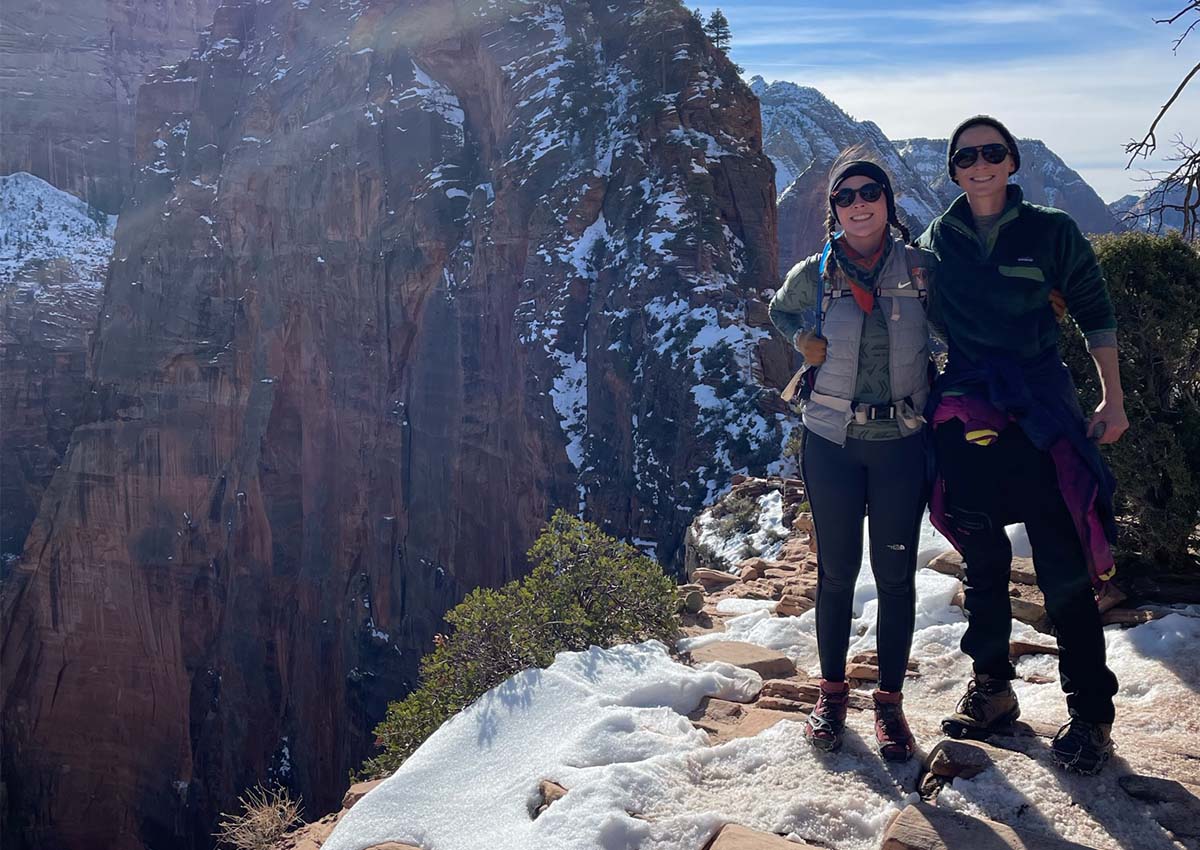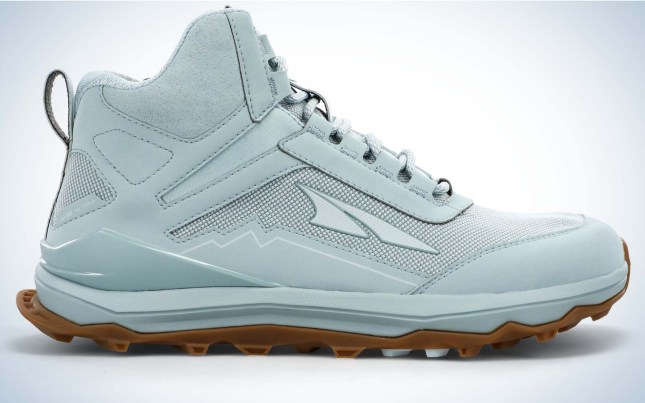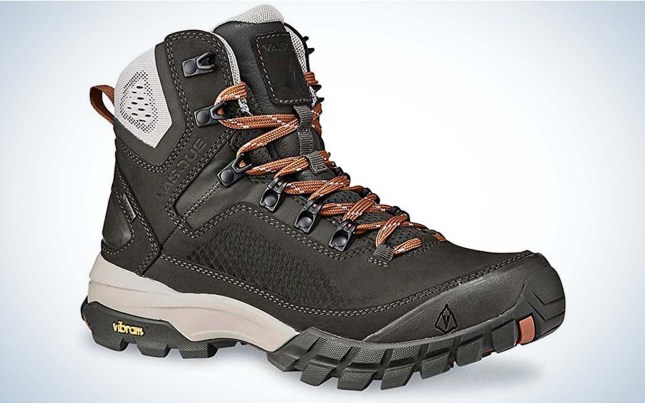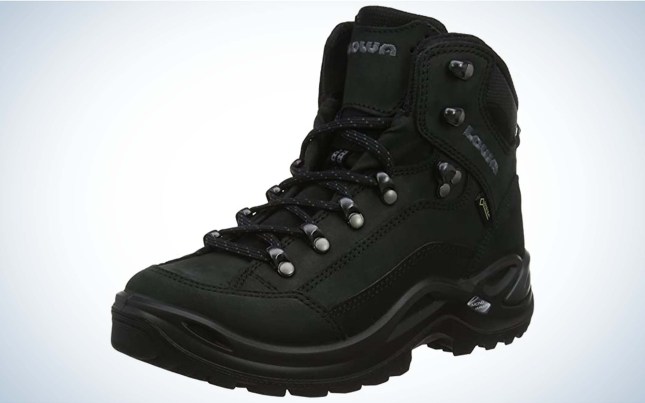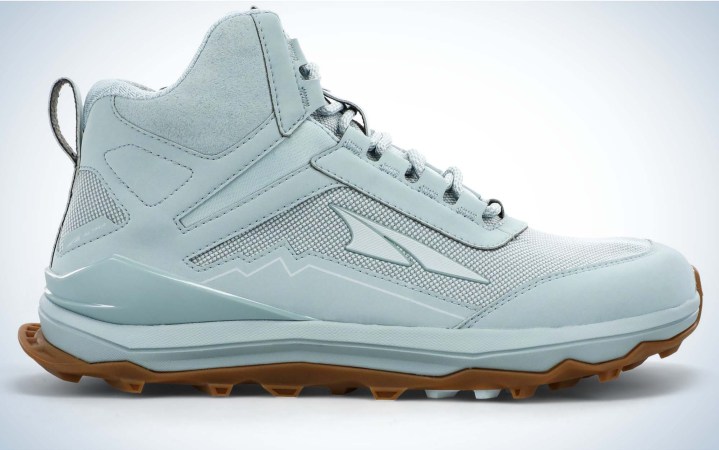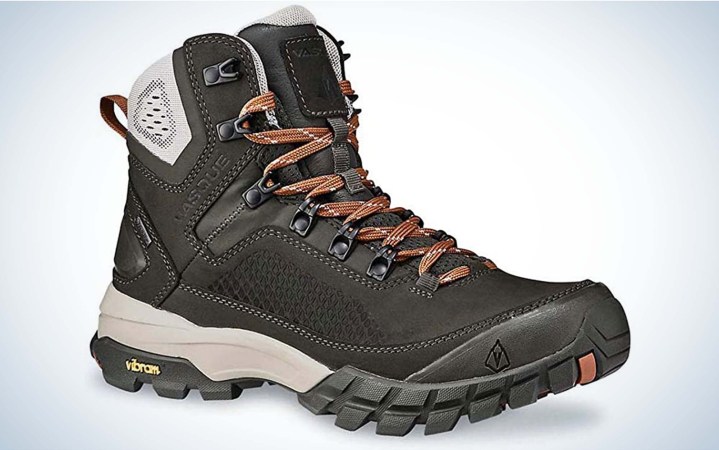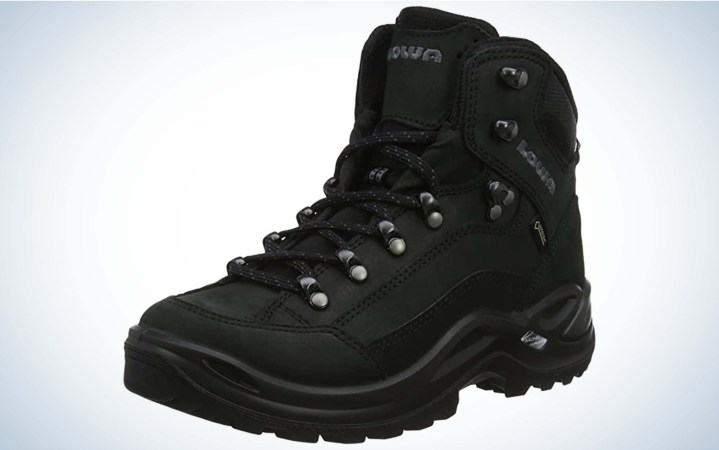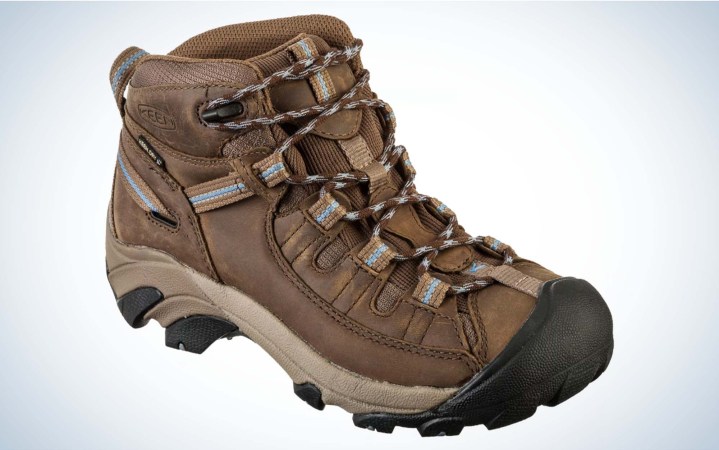We may earn revenue from the products available on this page and participate in affiliate programs. Learn More ›
Whether you’re a long-time backpacker or first-time hiker, choosing the best hiking boots for women can make or break her outdoors experience. But trying to glean the right choice from the sea of shoes sold in stores or worn on the trail is next to impossible: Everything is represented, from trail boots to lightweight hikers and mountaineering boots to hiking sandals. To help you find a pair that will keep you returning to the trail, I chatted with experienced hiking guides from across the country to learn what they think the best hiking boots for women are.
- Most Comfortable: Altra Lone Peak Hiker
- Most Versatile: Vasque Talus XT GTX
- Best Fit: Lowa Renegade GTX Mid Hiking Boots
- Best for Wide Feet: KEEN Women’s Targhee II Waterproof
Best Hiking Boots for Women: Reviews & Recommendations
Most Comfortable: Altra Lone Peak Hiker
Key Features
- Available Sizes: 5.5-12
- Weight: 1 pound, 3.8 ounces
- Available in black, blue, and khaki
Pros
- Minimal to no break-in time
- Wide toe box promotes good foot placement
Cons
- Less durable than other hiking boots
- Not as robust ankle protection
For Hannah Simmerman, a hiking guide with REI in Shenandoah National Park, the best hiking boots for women are the kissing cousin of what hikers and backpackers have long agreed is the best hiking shoe: the Altra Lone Peak 6. Read the OL gear team’s full test of the biggest shoe in backpacking here. Like the Altra Lone Peak 6, the Hiker’s wide toebox and zero heel drop promotes stability and correct foot placement (Simmerman also recommends this shoe to clients dealing with plantar fasciitis).
While one of the most appealing aspects of the lightweight Lone Peak Hiker is that, like many trail runners, it requires little to no break-in period, this does come with a catch: This shoe has very limited water resistance and is one of the least durable shoes on this list. If you’re looking for full protection that will last a lifetime, you’ll be better with the more expensive Vasque Talus XT GTX or Lowa Renegade GTX Mid Hiking Boots.
While Simmerman initially grabbed the Lone Peak Hikers for the heavy load she carries on client trips, she has started using these on personal trips as well.
“It’s nice sometimes to feel support on my ankle when I’m hopping around on rocks,” she says. “They feel more secure than trail runners.”
Most Versatile: Vasque Talus XT GTX
Key Features
- Available Sizes: 6-11
- Wide option available
- Weight: 2 pounds, 11 ounces
- Available in gray and auburn
Pros
- Great support
- Waterproof
Cons
- Expensive
- Heavy
Guide Emily Jo Mahan with The Yellowstone Hiking Guides knows firsthand the changes that hikers’ feet can go through over the course of the summer.
“My foot is a bit smaller at the beginning of the season, when I’m coming out of hibernation, than it will be by the end,” she says.
She’s found that the Vasque Talus XT GTX is one of the most forgiving shoe brands out there for sizing, and it works well across the half-size spectrum that her foot oscillates between during the summer season. To break in these boots, Mahan recommends wearing them around the house and on errands over the course of the week before trying them out on a longer backpacking trip. She also notes that a lot of injuries are just silly slips, which is why they ask people to use trekking poles on their guided trips.
For Mahan, the only downside of these boots, which last her about three seasons, is that Vasque updates them often enough that by the time she’s ready for a new pair, the boot is slightly different from what she had before.
Best Fit: Lowa Renegade GTX Mid Hiking Boots
Key Features
- Available Sizes: 5.5-11
- Wide option available
- Weight: 2 pounds, 2 ounces
- Available in a number of shades including black, beige, gray, purple, green, and red
Pros
- Best out-of-the-box for most foot types
- Fewer redesigns over the years than other hiking boots
Cons
- May not work well for individuals with truly wide feet
- Expensive
Having led guided trips to Big Bear, Los Angeles National Forest, and Ojai, California, hiking guide Christy Williamson has developed a lot of great boot and shoe recommendations. For a lighter day hike, she suggests the KEEN Targhee, which incorporates mesh into its waterproof design. For single-day slogs, the Salomon Speedcross—where you need some grip—or the stiff-soled La Sportiva Wildcats. For longer trips, the KEEN Pyrnees, a leather option that molds to your feet. When someone is looking for something attractive, she suggests the Danner Mountain 600. Clients with plantar fasciitis she points to the Techware Pro Ankle Brace Compression Sleeve.
But Williamson says that the Lowa Renegades are the best hiking boots for women just starting out. In her experience, these shoes are the ones that just work for the most number of people, providing the support and structure that you need for day hikes without creating blisters that can keep you from hiking the next day.
Best for Wide Feet: KEEN Targhee II Waterproof Mid Hiking Boots
Key Features
- Available Sizes: 5-11
- Wide option available
- Weight: 1 pound, 14 ounces
- Available in blue and brown
Pros
- Works well for people with wide feet
- Classic look at an affordable price
Cons
- Can delaminate after a season or two of use
Because women’s feet tend to be narrower on average than men’s, the best hiking boots for women are also narrower. This can pose a problem for women whose feet are wider than average, as a tight lateral fit can put excessive pressure on the ball of the foot, leading to foot pain. If you put a heavy load on your feet during the summer months, this can be especially true as feet tend to spread out when you’re hiking a high mileage over successive days. For hikers and backpackers that need a wider shoe, the guides I spoke with were unanimous that KEEN makes an excellent boot that works well for wider feet.
The KEEN Targhee III has long been a go-to choice for hikers, given its mix of ventilation and waterproofness it offer lighter weight and support. After using this boot myself for several years (my typical minimalist trail runner is not suitable for snow), I’m impressed by how well it balances comfort with protection. I don’t think there is a hiking boot you’ll ever truly forget you’re wearing, but this one comes close.
Things to Consider Before Buying Hiking Boots for Women
To learn more about how to choose between hiking boots, hiking shoes, and trail runners, I chatted with Kim Kelley, a member of REI’s virtual outfitting team. Here’s what she told me:
Hiking Boot, Hiking Shoe, or Trail Runner?
The choice between hiking boots, hiking shoes, and trail runners comes down to personal preference. Some like the secure fit of a hiking boot, while others prefer the more athletic feel of a trail runner, while still others are looking for something in between. Hiking boots, however, are preferred for off-trail or cross-country travel, as the stiffer shank of a hiking boot helps prevent the foot from becoming fatigued. But at the end of the day, the choice is about what’s most comfortable for the individual.
Ankle Support
A common misconception is that the upper of a hiking boot helps prevent ankle rolling. Unfortunately, the uppers of most hiking boots are not nearly stiff enough to prevent ankle rolling. These uppers do help prevent trail debris from getting inside your boot, and in the case of waterproof boots, can help keep your feet dry during stream crossings. What is protecting your ankle from rolling, however, is the rigidity of the base of the hiking boot. The thing that connects the heel to ankle support is the talus bone, which sits just above the heel bones and connects to ankle ligaments. To test the ankle support, simply twist the base of the boot. If it doesn’t move, the boot provides ankle support.
Arch Support
On long hikes or backpacking trips, it’s common for the arch of the foot to become fatigued, which can lead to a common ailment of hikers: plantar fasciitis. One cause of this, especially among day hikers and backpackers, is over pronation, or when your foot leans or collapses inward. Anyone experiencing this, or suffering from pain while they walk, can benefit from an insole like Superfeet (individuals with exceptionally strong arches may prefer a Currex insole).
Boot Size
With hiking boots, it’s important to have some space between your toes and the end of the boot—aim for about a finger’s width of space between the end of your toes and the tip of the boot. For most people, that works to about a half size larger than they typically wear. However, Kelley cautions that many people, especially women, rely on shoe sizings that they received when they were younger and don’t take into account the natural growth of the foot over time. Getting your foot sized by a professional—something you can do through REI’s Virtual Outfitting without visiting the store—is an important part of choosing a hiking boot.
FAQs
Hiking boots for women typically range in cost from $100 to upwards of $400.
There are some differences in how hiking boots are constructed to reflect the differences between men and women’s feet, including the width of the foot and the structure of the ankle support. However, it is fairly common for women to discover (sometimes after years of suffering too-small shoes) that the men’s styles simply fit her foot structure better. If you’re wondering if one of the best men’s hiking shoes or boots might be a better fit for you, then it’s worth heading to your local shoe retailer to give them a spin.
If you will be mainly day hiking, then planning to size up a half size is a good bet. But if you are planning to head out for a longer backpacking trip, it may be worth sizing up a whole size, as several guides I talked to suggested, to account for the foot growth that can occur over several days.
Methodology
It took me decades to find the right hiking and backpacking shoes. I spent years with shin splints, blisters smashed between my toes, and hot spots across the back of my heel. So I know how important choosing the right pair of hiking boots is for women. And I also know that the right boot or shoe for me might not be the right choice for you. So instead of basing the picks in this article off my own personal experience, I talked to a group of women who are hiking guides and have more experience than most on what hiking boots do (and do not) work for a wide range of people.
What was perhaps the most interesting thing about speaking to these women is that they all felt strongly about which hiking boot they would recommend to their clients, and yet all their picks were different. Their reasons for those different picks varied. Some valued comfort most highly, while others appreciated a boot that could be found in the same style, year after year. To help first-time hikers choose between these different recommendations, I sought to capture what each guide appreciated most about their boot choice and what foot structures they thought it would work best for. Additional insights can be found in our companion article, best hiking boots, which surveyed members of the Colorado Mountain Club.
Why Trust Outdoor Life?
Since 1898, OL has been a leading authority in testing and reviewing hunting gear, fishing tackle, guns and shooting equipment, and much more. We have more than a century-long history of evaluating products, and we’re now bringing that expertise to online reviews. Our editors are experienced outdoorsmen and women, and most importantly, we’re trained journalists. We prioritize field testing and objective data when reviewing products. We conduct interviews with gear manufacturers and engineers as well as outdoor experts so that our readers have an understanding of how and why a product works—or doesn’t.
Advertising does not influence our gear reviews and it never will. While we always focus our coverage on standout products—because we want our readers to be aware of the latest and greatest gear—we also cover the flaws and quirks of any given product.
Final Thoughts
After speaking with a number of hiking and backpacking guides about the best hiking boots for women, one thing was clear: No two feet are the same. Which choice is right for you will depend on a number of factors: your foot shape, how comfortable you prefer a boot to be, and how important support and structure are to you. One thing that everyone agreed on is that once you do find a hiking boot that works, you should jump on it. One guide I spoke with reported periodically searching eBay for listings of a hiking shoe she loves that has since been discontinued.
